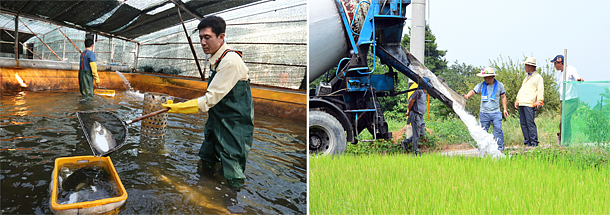Heat wave takes a toll on wildlife, too

Left: Fishermen collect dead flatfish from a fish farm in Pohang, North Gyeongsang, on Tuesday. Cultured fish continue to perish as the prolonged heat wave causes the temperature of water in fish farms to soar. Right: Farmers pump water into drought-ridden rice paddies in Namhae County, South Gyeongsang, on Tuesday. [NEWSIS]
The average daytime temperature in the first two weeks of August this year topped 29.7 degrees Celsius (85.4 degrees Fahrenheit), the hottest it’s been since 1907, when Seoul began to keep weather records.
In the past two weeks, for every night except for one Seoul observed so-called tropical nights, in which the overnight low stays above 25 degrees Celsius.
The last time it was nearly this hot in Seoul was 1994, when the average temperature of the first two weeks of August was 29.4 degrees Celsius. With heat alerts raised throughout the country, citizens are warned to take care, keep well hydrated throughout the day and avoid being out in the sun for long. Just last week, 520 people got sick from the intense heat, and since May, 13 people have died of heat illness. But the heat is getting to more than just humans.
Schools of rockfish perished under the relentless sun in South Chungcheong last week. As many as 10 fish farms in Seosan reported that their fish died in the heat. The Seosan city government cited the rising water temperature as the cause.
Heat alerts were issued in Seosan in the past two weeks, and at one point the average water temperature in the sea topped 30.1 degrees Celsius. According to the Seosan Fisheries Cooperative, roughly 8,110 kilograms (8.9 tons) of fish perished in the city as of Monday, an amount that is worth some 87 million won ($79,570).
The city government has collected the dead fish and placed them in an empty farm. It plans to request the National Institute of Fisheries Science to find out the exact cause of death and to request a recovery plan for the farmers, including a reduction of the interest rate on fishery funds.
“I am afraid that the number of fish perishing in the heat will only grow with time,” said a city government official. “The sea in some areas remains stagnant and once the water temperature rises, it takes a while for it to go down.”
Flocks of wild birds are also dying out from the heat.
In Incheon, some 400 wild birds, including greenshanks, were found dead and scattered throughout the mudflat in Songdo and the reservoirs in Nam-dong since mid-July. Among the dead was one black-faced spoonbill, one of the nation’s natural monuments and a globally endangered species.
Some birds are being found alive but physically paralyzed.
The city government and the National Institute of Fisheries Science suspect the birds are dying from botulism, or intoxication from the toxin released by a virus known as botulinum.
The botulinum virus breeds in deep grounds, but increases in number under warmer temperatures between July and September, and releases toxin into the air as they multiply.
Botulinum toxin is actually an ingredient included in Botox, the muscle-relaxing neurotoxin, often injected into the face to paralyze the muscles and treat wrinkles.
Animals who consume the toxin experience a nervous system shutdown that often leads to death. A vaccine for the toxin exists and can be injected into infected animals, but vaccinating all wild animals is, of course, impossible.
“The botulinum virus multiplied in number throughout the mudflats under the extended period of heat waves,” said Eum Jae-gu, a researcher at the National Institute of Environmental Research. “We suspect the birds, in finding their food in the mudflats, also consumed the toxin.”
Retrieving the dead birds has also been difficult.
“Most of the carcasses are scattered on mudflats that come up to the waist of an adult,” said an official of the Incheon city government. “Firefighters have retrieved some of the birds three times already but there are just too many carcasses out there.”
If the carcasses are neglected, the infection can spread rapidly as other birds may prey on their bodies.
Some suggested pouring water on the mudflats to bring down its temperature and reduce the breeding speed of the virus.
“Once the carcasses float on water, there is another risk of a secondary infection,” said Nam Seon-jung, a member of a civic protectionist group on black-faced spoonbill in Incheon. “The Chungnam Wild Animal Rescue Center and other authorities should devise a long-term plan to stall further damages.”
BY KANG CHAN-SU, SHIN JIN-HO AND CHOI MO-RAN [chung.juhee@joongang.co.kr]










with the Korea JoongAng Daily
To write comments, please log in to one of the accounts.
Standards Board Policy (0/250자)